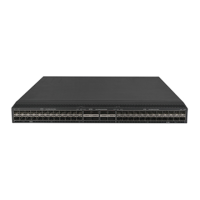9
Edge aggregate interface
Dynamic link aggregation fails on a server-facing aggregate interface if dynamic link aggregation is
configured only on the device. The device forwards traffic by using only one of the physical ports that
are connected to the server.
To improve link reliability, configure the aggregate interface as an edge aggregate interface. This
feature enables all member ports of the aggregation group to forward traffic. When a member port
fails, its traffic is automatically switched to other member ports.
After dynamic link aggregation is configured on the server, the device can receive LACPDUs from
the server. Then, link aggregation between the device and the server operates correctly.
An edge aggregate interface takes effect only when it is configured on an aggregate interface
corresponding to a dynamic aggregation group.
Load sharing modes for link aggregation groups
In a link aggregation group, traffic can be load shared across the Selected ports based on any of the
following modes:
• Per-flow load sharing—Distributes traffic on a per-flow basis. The load sharing mode
classifies packets into flows and forwards packets of the same flow on the same link. This mode
can be one of or a combination of the following traffic classification criteria:
{ Ingress port.
{ Source or destination IP.
{ Source or destination MAC.
{ Source or destination port number.
{ MPLS label.
• Per-packet load sharing—Distributes traffic on a per-packet basis.
• Automatic load sharing—Automatically selects a load sharing mode depending on the packet
type. For example, the load sharing mode differs between IPv4 packets and Layer 2 packets.
This mode is also called the flexible mode.
S-MLAG
Simple multichassis link aggregation (S-MLAG) enhances dynamic link aggregation to establish an
aggregation that spans multiple devices to a remote device.
An S-MLAG multichassis aggregation connects one dynamic Layer 2 aggregate interface on each
S-MLAG device to the remote device, as shown in Figure 5.
S-MLAG use
s an S-MLAG group to manage the aggregate interfaces for each aggregation, and it
runs LACP to maintain each aggregation as does dynamic link aggregation. To the remote device,
the S-MLAG devices appear as one peer aggregation system.

